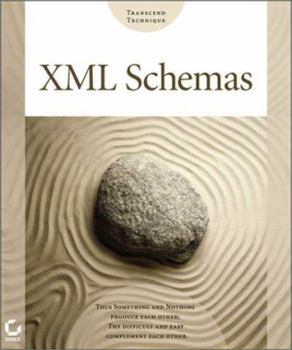XML Schemas
Whether it is used for web development, creating documentation, or exchanging data between business partners, XML continues to grow in importance as a highly flexible document-design and data-modeling tool. Despite the limitations of using SGML Document Type Definitions (DTDs) to define document structures, XML has made inroads wherever data must flow among disparate platforms. The Schema specification has achieved W3C recommendation status, providing...
Format:Paperback
Language:English
ISBN:0782140459
ISBN13:9780782140453
Release Date:January 2002
Publisher:Sybex
Length:656 Pages
Weight:2.38 lbs.
Dimensions:1.4" x 7.6" x 9.0"
Customer Reviews
1 rating
Helpful, but ...
Published by Thriftbooks.com User , 18 years ago
I wanted a quick transition from XML DTDs to schemas when I picked up this book. As it turned out, I chose better than I knew. This isn't just a book about the W3C standard XML schemas, it specifically addresses the developer making the transition from DTDs. And, despite what you might guess from the title, it acknowledges that DTDs still have a place in the world of schemas. After its attention to DTDs and their schema counterparts, this book's big strength is in numerous and detailed examples. Every construct is shown real code samples, often in multiple samples. That certainly helps the cut & paste coder. It's also good for the more thoughtful programmer, one trying to pick up good development style as well as the basics of syntax and semantics. The authors become overly dependent on the examples, however. Again and again, they introduce some new aspect of schema development, offer a few examples, then stop. Although the reader now knows how say the new words in grammatically correct ways, she is left with no definition of just what those words mean. As an example, the "collapse" value of the "whiteSpace" facet is introduced on p.138 (even though the index says p.137), but not defined for another 400 pages. Namespaces are presented similarly and used pervasively, but their real purpose is illustrated poorly if at all: they allow the same element name to be imported from different schema fragments, but used in unambiguously different ways. In other places, two slightly different code fragments are used to ilustrate some distinction. In discussing "definition" vs. "declaration," for example, the differences are so small that finding them becomes a "where's Waldo" exercise that just a little typographic enhancement could have clarified. Attention to detail faltered in other ways, too. A few places omit closing delimiters: opening "", and ditto quote marks. ISBNs appear repeatedly in examples, but are generally described as 10-digit numbers. Only a late example imported from another source acknowledges that the letter X may appear in the last position. Examples with addresses, phone numbers, and postal codes show no awareness of internationalization issues, or even of American conventions like apartment numbers in street addresses, PO boxes, and APO addresses. The cautious reader should study their XML and schema usage, but eye the application content in the most critical way. Also, as noted above, indexing could have been a lot more helpful. Still, it's user-friendly introduction to the complexities of XML schemas. It addresses the common case of a developer moving from DTDs to schemas, without the impenetrable density of the W3C standards. It also mentions some of the competing mechanisms, including Oasis's RELAX. The book has flaws, and could have in-lined a little discussion of XPath and regular expressions instead of pointing to standards, but generally stands well by itself. There may be better references out there, but this one should g






